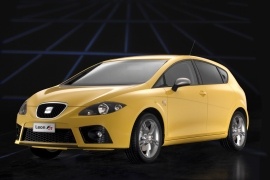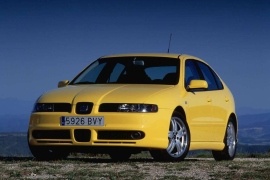SEAT Leon FR / Topsport Models/Series Timeline, Specifications & Photos
First production year: 2002
Engines: Diesel, Gasoline
Body style: Hatchback
SEAT introduced the FR as its high-performance hot-hatch on the market in 2006, and it was basically a reshaped Volkswagen Golf GTI.
Many customers complained about the bland styling of the Volkswagen Golf. Although it remained for decades on top of the hatchback customers' lists, its exterior design was nothing to write home about it. But then, after the German manufacturer decided to do something with the Spanish brand SEAT and allowed it to create its own design language, things took a different turn.
The Leon was in its second generation when it came on the market in 2005 and surprised the customers with its fluid shapes and waved lines that created a dynamic look. Come 2006, the Spanish brand unveiled the FR version, which was not the most powerful version for it, but it was an adequate mix for use as a family vehicle and a sporty hot-hatch. The redesigned front bumper sported a broader center air intake on the lower side flanked by two scoops for the fog lamps. In addition, the car came fitted with unique light-alloy wheels. At the back, the carmaker lost its appetite for showing off and just painted a big chunk of the rear bumper black and kept a dual exhaust on the side.
Inside, SEAT offered high-bolstered seats for the front occupants, while a pair of Recaro Sports seats were available as an option. Inside the instrument cluster, the dials received an upgraded design with silver background and red needles. Last but not least, the center-mounted tachometer
sported the FR logo on it.
Under the hood, SEAT carried over the same 2.0-liter turbocharged gasoline engine from Volkswagen Golf GTI. It was paired with a six-speed manual, while a six-speed automatic (dual-clutch) was on the options list.
The 2002 SEAT Leon FR was based on the successful SEAT Leon I, which was launched in 1998. It shared the same platform with other compact class vehicles from the Volkswagen group, including the Golf.
Volkswagen's road to the premium market started way back in the '80s. Its idea was to transform the Spanish brand SEAT into a mass-volume car-company, and the German would fill the gap between a mass-market car and a premium car company. But the SEAT needed a stronger image on the market, and that could have been achieved via a sporty model with a price lower than of a Golf GTI.
In 2002, the SEAT Leon received an FR version. It was based on the regular SEAT Leon, but with a stronger appearance. It was an evolution over the Cupra version. When compared to that, from the outside, there was a different front bumper and featured specific design of five twin-spoke 17" light-alloy wheels. The name FR stands for Formula Racing. The idea was to build a sporty image for the Spanish brand. In 2003, the brand launched a one-make trophy, the Supercopa SEAT Leon. All the vehicles were based on the Leon FR model.
Inside the cabin, there was room for five and sport-bucket seats for the front passengers. The analog dials featured red-needles on white background for the dials.
Underneath the car, there was a fully independent suspension for both axles. Despite the fact that some SEAT Leon models were equipped with an all-wheel-drive system, the FR was front-wheel-drive only. There was only a six-speed manual offered for that version. It was equipped with either a 1.8-liter 20-valves gasoline engine or a 1.9-liter diesel. Both versions were turbocharged.

